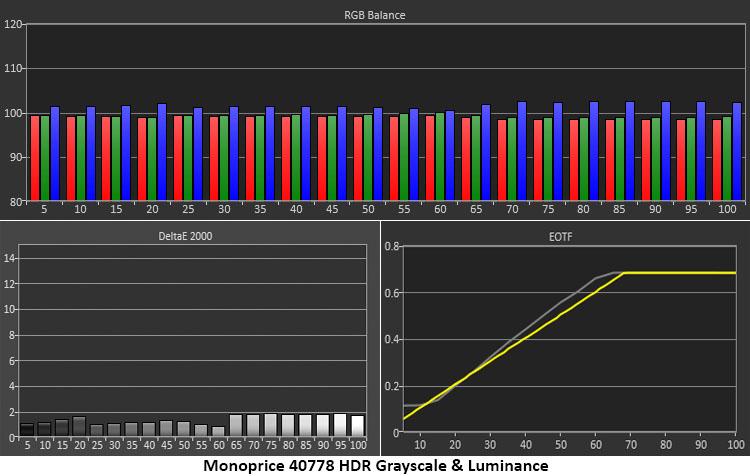Why you can trust Tom's Hardware
Our HDR benchmarking uses Portrait Displays’ Calman software. To learn about our HDR testing, see our breakdown of how we test PC monitors.
To engage the Dark Matter 27’s HDR mode, apply an HDR10 signal, then switch on HDR in the Gaming Setup menu. Note that the BenQ XL2546K doesn’t support HDR so it has been left out of this section of the review.
HDR Brightness and Contrast



You can see that the Monoprice is quite a bit brighter than the Pixio, further highlighting the differences between the two displays. At over 522 nits, it’s one of the brighter HDR monitors we’ve tested. It doesn’t carry any certifications from VESA, but it obviously qualifies for DisplayHDR 400 capability.
With no dynamic contrast available, there isn’t any more dynamic range for HDR material but that is true of all the monitors here. Obviously, the AOC has an advantage, but it too does not expand its contrast for HDR. In the realm of budget HDR monitors, the Dark Matter 27 delivers average HDR contrast but its extra brightness may appeal to some users.
Grayscale, EOTF and Color


The Dark Matter 27’s HDR mode locks out all image controls but that doesn’t prevent it from delivering very accurate HDR color. It’s better than the default SDR mode in fact. Grayscale appears slightly blue in the chart, but the actual error is invisible.
The EOTF curve rises a bit too quickly and transitions to tone mapping about 10% too early. That will raise midtone brightness a little but most content won’t show a problem. We also observed a rise in black levels at the extreme dark end of the scale, but this too is a minor issue. Overall, the image has the same contrast for SDR and HDR, but the latter picture is brighter since the backlight is at its maximum level.
Get Tom's Hardware's best news and in-depth reviews, straight to your inbox.
Current page: HDR Performance
Prev Page Grayscale, Gamma and Color Next Page Viewing Angles, Uniformity, Response and Lag
Christian Eberle is a Contributing Editor for Tom's Hardware US. He's a veteran reviewer of A/V equipment, specializing in monitors. Christian began his obsession with tech when he built his first PC in 1991, a 286 running DOS 3.0 at a blazing 12MHz. In 2006, he undertook training from the Imaging Science Foundation in video calibration and testing and thus started a passion for precise imaging that persists to this day. He is also a professional musician with a degree from the New England Conservatory as a classical bassoonist which he used to good effect as a performer with the West Point Army Band from 1987 to 2013. He enjoys watching movies and listening to high-end audio in his custom-built home theater and can be seen riding trails near his home on a race-ready ICE VTX recumbent trike. Christian enjoys the endless summer in Florida where he lives with his wife and Chihuahua and plays with orchestras around the state.